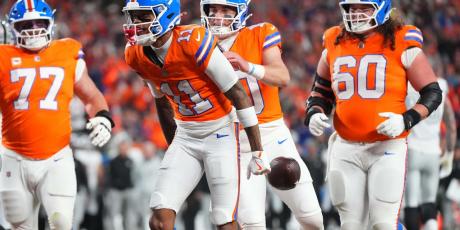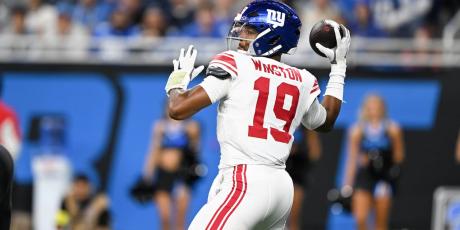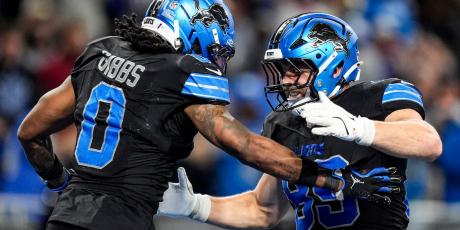WR Draft Strategy: How to Attack the Position in 2018

Wide Receivers in 2017 were like mumble rap: Disappointing and almost incomprehensibly bad. Business may be booming for Antonio Brown, who just showed up to training camp in a chopper, but owners of Odell Beckham Jr. and Julio Jones were pretty much ready to take their toaster in the bath by last season’s end. Some were ready to nosh their Arby’s much earlier.
The backlash has been predictable. Our lizard brains can only remember back—at most—16 months, and coupled with the stellar performances of players like Todd Gurley, LeVeon Bell, and Alvin Kamara, the public is fading the WR position hard. There are just three WRs going in the first round this season, and everyone’s favorite punching bag, Julio Jones, has fallen out of the first round entirely (#neverjulio). The disgust is palpable.
More 2018 Positional Draft Strategies: IDP | TE | DST | QB | RB
But where other analysts might see a cesspool of low-scoring uncertainty, I see opportunity. If you are bold and want to play to win, there is a clear path to owning two, and maybe even three probable WR1s in your draft this year.
Below I discuss how to tailor your WR strategy to your draft position. I assume a 12-round snake draft and provide average draft position (ADP) and positional ADP rankings from 4for4’s Multi-site ADP tool, as well as rankings from my Air Yards model to help anchor things. The Air Yards model generally agrees with this year’s ADP, but when it doesn’t there is usually something worth paying attention to. (Editor's Note: You can also cross-reference ADP and the Air Yards model with WR rankings—PPR and Standard—from our own John Paulsen). Also, For the curious, at the end of this article is the model’s top-36 WRs, along with a PPR points per game projection for each receiver. All route data is courtesy of Sports Info Solutions.
Editor's Note: For more information on what air yards are and why they matter, read Josh's Air Yards Explained article.
Early-Round Pick WR Strategy
Round 1
If you are picking early, I can’t argue against grabbing one of the big-four running backs (David Johnson, Todd Gurley, LeVeon Bell, or Ezekiel Elliott) and then shifting your focus to drafting two very solid WRs on the way back.
If you do choose to go WR early (and I salute you, champion), Antonio Brown (ADP: 5th overall/WR1, Air Yards Model Rank: 1) is the clear choice. In fantasy, the driver of points is targets and the air yards behind them. Of the two, targets are about twice as important. In 2017, Antonio Brown recorded double-digit targets on seven different routes. A total of 13 percent of his targets came on Slants where he posted 9.2 yards per target (YPT) on routes with an average depth of target (aDOT) of 7.4 yards. Ben Roethlisberger is reportedly in the best shape of his 15-year career, and Brown has a capable batterymate who can dance like nobody's business in JuJu Smith-Schuster. Brown is as close to a lock for WR1 status as you can get in fantasy football.
Rounds 2 and 3
After your first-round pick, players like Mike Evans (ADP: 23rd overall/WR 9, Air Yards Model Rank: 7), Adam Thielen (ADP: 26th overall/WR10, Air Yards Model Rank: 5), and Larry Fitzgerald (ADP: 33rd overall/WR14, Air Yards Model Rank: 9) are usually there for the taking at the round 2-3 turn.
Like Brown, Evans earned double-digit targets on seven different routes in 2017. A total of 21 percent of Evans' targets came on the Curl route, where he was relatively inefficient, posting 5.8 YPT on an aDOT of 8.9. On the bright side, the Bucs targeted Curl routes 40 percent more than any other route in 2017, and as a rule, NFL offenses tend to run a similar number and type of each route year over year. This means that even with Jameis Winston's absence for the first three games due to suspension, the odds are very good that Evans' bread and butter route will continue to be there for him. Plus, he donated $10,000 to a good cause recently, so we know his head is in the right place.
Adam Thielen earned double-digit targets on four different routes in 2017 (though he earned nine targets on three more), with 17 percent of those targets on Curl routes. It’s incredible to think that just two years ago Thielen was known more for his grit than his efficiency, but in the past two years he's made a name for himself through his exceptional guile and mental toughness. On three of the four routes he was targeted on 10 or more times, his RACR was over one, meaning he caught and then created more than a yard for every air yard thrown at him by Case Keenum and Sam Bradford. He was the second-most efficient receiver in the NFL on Slants last season, creating 2.58 receiving yards for every air yard throw at him. That's incredible efficiency and a testament to his tremendous grit.
Larry Fitzgerald has been good for so long we tend to take him for granted. Many are predicting a down year for Fitzgerald with upheaval at the quarterback position in Arizona again this year and the prospect of catching passes from a rookie QB if Sam Bradford’s wonky knees don’t prove to be healthy. Last season, after David Johnson and then Carson Palmer went down, many analysts (myself included) believed Fitzgerald would quickly become a fantasy afterthought. This was decidedly not the case, however. In the seven games Palmer was healthy, Fitzgerald averaged 9.3 targets per game for a 23 percent target share. In the nine games without Palmer, he averaged 10.7 targets per game with a 30 percent target share. When you add in air yards and use my Weighted Opportunity Rating (WOPR) metric, we see that Fitzgerald’s opportunity jumped from 0.45 to 0.61 after Palmer was injured—a 26 percent increase. Fitzgerald’s PPR points per game also increased, rising from 16.1 to 16.5. There is no reason to believe Sam Bradford or Josh Rosen isn’t an improvement upon Drew Stanton, and the Cardinals have David Johnson back and healthy as an outlet receiver and intermediate threat to take the pressure off of Fitzgerald. Another solid year is likely.
If you went RB in round one, select two of these studs and don’t look back. If you took Brown in the first, consider mixing in a running back. You’ll have another opportunity to add a WR with a top-12 ceiling later.
Rounds 4 and 5
In the fourth and fifth rounds you can snag one more WR from a group that likely includes Jarvis Landry (ADP: 61st overall/WR25, Air Yards Model Rank: 16), Marvin Jones (ADP: 60th overall/WR24, Air Yards Model Rank: 26), or Golden Tate (ADP: 49th overall/WR22, Air Yards Model Rank: 28).
Jarvis Landry gets dragged quite a bit for his low yards per target, but he’s actually one of the more productive receivers in the game. Landry earned double-digit targets on six different routes in 2017, and on each had no worse than a RACR of 0.96. That is very good efficiency. His aDOT on slants was deeper than you might think: 8.1 yards downfield, and his YPT was 8.3 (RACR of 1.02). With Josh Gordon out indefinitely, it’s probable that Landry will continue to see targets on Outs, Curls Slants, and Digs—where he shines bright like a diamond.
Jones and Tate are basically interchangeable commodities in terms of fantasy points. On a week-to-week basis, Tate may provide a slightly higher floor due to his higher target share. Which one you choose will depend upon the other receivers you have on your team. Jones can be a weekly winner with his higher upside due to his usage in the deep game. Jones saw double-digit targets on five routes in 2017, and nine on the Fade, a route used almost exclusively in the red zone. Tate saw double-digit targets on four routes, with 41 percent coming on Screens and Digs. Detroit does a very good job targeting a variety of routes, and I expect that to continue in 2018.
If you went WR-WR at the round 2-3 turn, my preference here is to use one of the third- or fourth-round picks on a rookie RB who looks like he will receive an immediate opportunity. Backs like Rashaad Penny, Derrius Guice, Sony Michel, Ronald Jones, or Royce Freeman are a great pairing with your stud RB from the first round, or a fantastic start to a classic Zero-RB roster if you went Antonio Brown early.
The receiver I recommend you fade at his current ADP when drafting early is DeAndre Hopkins (ADP: 8th overall/WR2). Based on his past production, career efficiency, QB, offensive line, and projected volume, the model believes the public is higher on him than is warranted. Deshaun Watson’s TD rate will surely regress in 2018, and his ability to successfully work through his progressions is still an open question. Nuk is a good receiver, and he’ll see his share of targets, but his ADP is just too rich.
Middle-Round Pick WR Strategy
Continue reading to see how Josh attacks the wide receiver position if you have a middle-round pick, what his plan is with a late-round pick, and for a top-36 WRs ranking, according to his Air Yards model...

- All Premium Content
- The most Accurate Rankings Since 2010
- Expert Draft Picks w/DraftHero
- Highest Scoring Lineup + Top Available Players w/LeagueSync
- ...and much much more






















